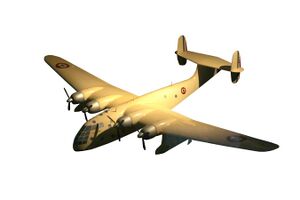Engineering:Bréguet 730
| Br.730/Br.731 | |
|---|---|

| |
| Bréguet 731 Bellatrix model at Musée national de la Marine. | |
| Role | Reconnaissance Flying Boat |
| Manufacturer | Bréguet |
| First flight | 4 April 1938 (Br 730) 2 September 1947 (Br 731) |
| Introduction | 1945 |
| Retired | 1954 |
| Primary user | French Navy |
| Number built | 5 |
The Bréguet 730 was a French flying boat of the 1930s. Built to meet the requirements of the French Navy, it was ordered into production but no aircraft were delivered before France surrendered to Germany in June 1940. Four remaining incomplete airframes were completed after the end of World War II, serving with the French Navy until 1954.
Development
The French Navy issued a specification for a new long-range flying boat to replace the obsolete 521 Bizerte in May 1935. Bréguet designed a large four engined flying boat to meet the requirement, the Breguet 730, competing against designs by Latécoère (the Latécoère 611), Lioré et Olivier (the LeO H-440) and Potez-CAMS (the Potez-CAMS 141).
The first prototype, the Br.730-01, powered by 750 kW (1,010 hp) Gnome-Rhône 14N-2 and Gnome-Rhône 14N-3 engines, flew on 4 April 1938 at Le Havre. The N-2 engines were fitted at No.1 and No.3 positions and the N-3s at No.2 and No.4 positions, rotating in opposite directions.[1] It was wrecked, however, on 16 July 1938 when it attempted to land in shallow water. Despite this setback, however, an order for four production aircraft was placed, followed by a contract for unlimited production on the outbreak of World War II in September 1939. This order was cut in early 1940 when it realised that attrition of maritime patrol aircraft was very low.[1]
Operational history
No production aircraft had been completed when France surrendered on 22 June 1940, when production was suspended. It was restarted by the Vichy government, with the wing of the wrecked prototype being combined with the hull of the first production machine to produce the Br. 730 No.1, which was ready to fly when the German invasion of Vichy France prevented testing. Production of the remaining 11 aircraft continued extremely slowly under German occupation, with eight being destroyed in an Allied air raid on 6 April 1944.[1]
The Br.730 No.1 was finally flown for the first time in December 1944, after the Germans retreated from the South of France. This aircraft, named Véga, was delivered to the French Navy, who used it as a long-range transport in April 1945,[2] with a second Br.730 (Sirius) completed in May 1946.[1] The remaining two aircraft (Altair and Bellatrix) were completed with redesigned nose, new floats and more powerful engines, and were designated Br.731.
Véga was destroyed in a crash in January 1949,[2] with a second aircraft being destroyed in 1951.[3] The last Br.731 was retired on 20 January 1954.[3]
Variants
- Br.730-01
- Prototype. Powered by four 753 kW (1,010 hp) Gnome-Rhône 14N 2/3 engines.
- Br.730
- Production version. Powered by four 835 kW (1,120 hp) Gnome-Rhône 14N 44/45 engines. Two built.
- Br.731
- Modified nose and floats. Powered by 1,010 kW (1,350 hp) Gnome-Rhône 14R 200/201 engines. Two built.
Operators
![]() France
France
- French Navy
Specifications (Br.730)
Data from Warplanes of the Second World War, Volume Five, Flying Boats [1] Jane's all the World's Aircraft 1947[4]
General characteristics
- Crew: 10
- Length: 24.38 m (80 ft 0 in)
- Wingspan: 40.37 m (132 ft 5 in)
- Height: 8.6 m (28 ft 3 in)
- Wing area: 173.1 m2 (1,863 sq ft)
- Aspect ratio: 9.3
- Empty weight: 16,134 kg (35,569 lb)
- Gross weight: 28,660 kg (63,184 lb)
- Powerplant: 2 × Gnome-Rhône 14N-44 14-cyl. air-cooled radial piston engines, 836 kW (1,121 hp) each right hand rotation
- Powerplant: 2 × Gnome-Rhône 14N-45 14-cyl. air-cooled radial piston engines, 836 kW (1,121 hp) each left hand rotation
- Propellers: 3-bladed variable-pitch airscrews
Performance
- Maximum speed: 330 km/h (210 mph, 180 kn)
- Cruise speed: 230 km/h (140 mph, 120 kn)
- Range: 6,923 km (4,302 mi, 3,738 nmi)
- Endurance: 30 hours
- Service ceiling: 6,000 m (20,000 ft)
- Time to altitude: 3,000 m (9,800 ft) in 9 minutes
- Wing loading: 165 kg/m2 (34 lb/sq ft)
- Power/mass: 0.117 kW/kg (0.071 hp/lb)
See also
Aircraft of comparable role, configuration and era
Related lists
References
- ↑ Jump up to: 1.0 1.1 1.2 1.3 1.4 Green, William (1968). Warplanes of the Second World War, Volume Five, Flying Boats. London: Macdonald. pp. 10–12. ISBN 978-0-356-01449-4.
- ↑ Jump up to: 2.0 2.1 "Histoire de la BAN Saint-Mandrier (1944–1950)" (in fr). http://www.netmarine.net/aero/bases/stmandrier/histoire/histoire04.htm.
- ↑ Jump up to: 3.0 3.1 "Histoire de la BAN Saint-Mandrier (1951–1959)" (in fr). http://www.netmarine.net/aero/bases/stmandrier/histoire/histoire05.htm.
- ↑ Bridgman, Leonard, ed (1947). Jane's all the World's Aircraft 1947. London: Sampson Low, Marston & Co. pp. 119c.
Bibliography
- Bousquet, Gérard (2013). French Flying Boats of WW II. Sandomierz, Poland: Stratus. ISBN 978-83-63678-06-7.
- Chillon, Jacques; Dubois, Jean-Pierre; Wegg, John (1980). French Post-War Transport Aircraft. Tonbridge, UK: Air-Britain. ISBN 0-85130-078-2.
- Cuny, Jean (1989). Les avions de combat français, 2: Chasse lourde, bombardement, assaut, exploration. Docavia. 30. Ed. Larivière. OCLC 36836833.
- Cuny, Jean; Leyvastre, Pierre (1977) (in fr). Les Avions Breguet (1940/1971). Docavia. 6. Paris: Editions Larivière. OCLC 440863702.
- Lacaze, Henri (2016) (in fr). Les avions Louis Breguet Paris. 2: le règne du monoplan. Le Vigen, France. ISBN 978-2-914017-89-3.
External links
 |



